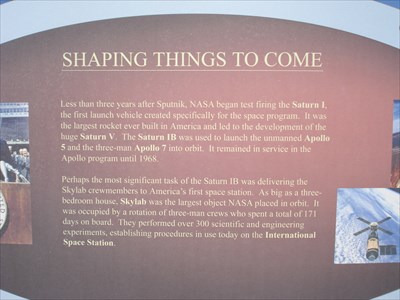
Shaping Things To Come - Kennedy Space Center
N 28° 31.422 W 080° 41.000
17R E 530983 N 3155258
This plaque is located in the Rocket Garden at the Kennedy Space Center Visitor Center.
Waymark Code: WM8JMN
Location: Florida, United States
Date Posted: 04/10/2010
Views: 11

SHAPING THINGS TO COME
Less than three years after Sputnik, NASA began test firing the Saturn I, the first launch vehicle created specifically for the program. It was the largest rocket ever built in America and led to the development of the huge Saturn V. The saturn IB was used to launch the unmanned Apollo 5 and the three-man Apollo 7 into orbit. It remained in service in the Apollo program untill 1968.
Perhaps the most significant task of the Saturn IB was delivering the Skylab crewmembers to America's first space station. As big as a three bedroom house, Skylab was the largest object NASA placed in the orbit. It was occupied by a rotation of three-man crews who spend a total of 171 days on board. They performed over 300 scientific and enginering experiments, established procedures in use today on the International Space Station.
From: Wikipedia
Skylab
Skylab was the United States' first space station, and the second space station visited by a human crew. It was also the only space station NASA launched alone. The 100-ton space station was in Earth's orbit from 1973 to 1979 and it was visited by crews three times in 1973 and 1974.
Skylab history
On 8 August 1969, the McDonnell Douglas Corporation received a contract for the conversion of two existing S-IVB stages to the Orbital Workshop configuration. One of the S-IV test stages was shipped to McDonnell Douglas for the construction of a mock-up in January 1970. The Orbital Workshop was renamed "Skylab" as a result of a NASA contest. The actual stage that flew was the upper stage of the AS-212 rocket (the S-IVB stage). The mission computer used aboard Skylab was the IBM System/4Pi TC-1, a relative of the AP-101 Space Shuttle computers.
Skylab was launched 14 May 1973 by a Saturn INT-21 (a two-stage version of the Saturn V rocket) into a 235 nautical mile (435 km) orbit. The launch is sometimes referred to as Skylab 1, or SL-1. Severe damage was sustained during launch, including the loss of the station's micrometeoroid shield/sun shade and one of its main solar panels. Debris from the lost micrometeoroid shield further complicated matters by pinning the remaining solar panel to the side of the station, preventing its deployment and thus leaving the station with a huge power deficit. The station underwent extensive repair during a spacewalk by the first crew, which launched on 25 May 1973 (the SL-2 mission) atop a Saturn IB. If the crew had failed to repair Skylab in time, the plastic insulation inside the station would have melted, releasing poisonous gas and making Skylab completely uninhabitable. They stayed in orbit with Skylab for 28 days. Two additional missions followed with the launch dates of 28 July 1973 (SL-3) and 16 November 1973 (SL-4) with mission durations of 59 and 84 days, respectively. The last Skylab crew returned to the Earth on 8 February 1974.
Operations in orbit
Skylab orbited Earth 2,476 times during the 171 days and 13 hours of its occupation during the three manned Skylab missions. Astronauts performed ten spacewalks totaling 42 hours 16 minutes. Skylab logged about 2,000 hours of scientific and medical experiments, including eight solar experiments. The Sun's coronal holes were discovered because of these efforts. Many of the experiments conducted investigated the astronauts' adaptation to extended periods of microgravity. Each Skylab mission set a record for the amount of time astronauts spent in space.